Enhancement of Spreadability in Haynes 230 Powder via In Situ Micro-Oxidation Gas Atomization for Additive Manufacturing Process
Abstract
1. Introduction
2. Experimental Methods
- Powder 1 was obtained through the gas atomization production route.
- Powder 2 was produced using the gas atomization and ISMO production route.
3. Results and Discussion
4. Conclusions
Author Contributions
Funding
Institutional Review Board Statement
Informed Consent Statement
Data Availability Statement
Conflicts of Interest
References
- Katcher, M.; Klarstrom, D.L. A review of Haynes® 230® and 617 alloys for high temperature gas cooled reactors. Mater. Sci. Forum. 2008, 595, 511–517. [Google Scholar] [CrossRef]
- Boehlert, C.J.; Longanbach, S.C. A comparison of the microstructure and creep behavior of cold rolled HAYNES® 230 alloy™ and HAYNES® 282 alloy™. Mater. Sci. Eng. A 2011, 528, 4888–4898. [Google Scholar] [CrossRef]
- Luo, R.; Liu, Q.; Gao, P.; Liu, T.; Ding, H.; Zhang, D.; Cao, Y.; Cheng, X. Effect of microstructural evolution and mechanical properties of Haynes 230 superalloy during long-term aging at 700 °C. J. Alloys Compd. 2023, 947, 169495. [Google Scholar] [CrossRef]
- Kim, D.; Sah, I.; Kim, D.; Ryu, W.-S.; Jang, C. High temperature oxidation behavior of alloy 617 and Haynes 230 in impurity-controlled helium environments. Oxid. Met. 2011, 75, 103–119. [Google Scholar] [CrossRef]
- Changheui, J.; Daejong, K.I.M.; Donghoon, K.I.M.; Injin, S.A.H.; Woo-Seog, R.Y.U.; Yoo, Y.S. Oxidation behaviors of wrought nickel-based superalloys in various high temperature environments. Trans. Nonferrous Met. Soc. China 2011, 21, 1524–1531. [Google Scholar] [CrossRef]
- Yang, B.; Shang, Z.; Ding, J.; Lopez, J.; Jarosinski, W.; Sun, T.; Richter, N.; Zhang, Y.; Wang, H.; Zhang, X. Investigation of strengthening mechanisms in an additively manufactured Haynes 230 alloy. Acta Mater. 2022, 222, 117404. [Google Scholar] [CrossRef]
- Bauer, T.; Dawson, K.; Spierings, A.B.; Wegener, K. Microstructure and mechanical characterisation of SLM processed Haynes® 230®. In Proceedings of the 26th Annual International Solid Freeform Fabrication Symposium, Austin, TX, USA, 10–12 August 2015; Laboratory for Freeform Fabrication and University of Texas at Austin: Austin, TX, USA, 2015; pp. 813–822. Available online: https://hdl.handle.net/2152/89380 (accessed on 24 March 2023).
- Safaei, K.; Abedi, H.; Nematollahi, M.; Kordizadeh, F.; Dabbaghi, H.; Bayati, P.; Javanbakht, R.; Jahadakbar, A.; Elahinia, M.; Poorganji, B. Additive manufacturing of NiTi shape memory alloy for biomedical applications: Review of the LPBF process ecosystem. J. Miner. 2021, 73, 3771–3786. [Google Scholar] [CrossRef]
- Dunbar, A.J.; Denlinger, E.R.; Heigel, J.; Michaleris, P.; Guerrier, P.; Martukanitz, R.; Simpson, T. Development of experimental method for in situ distortion and temperature measurements during the laser powder bed fusion additive manufacturing process. Addit. Manuf. 2016, 12, 25–30. [Google Scholar] [CrossRef]
- Cao, S.; Zou, Y.; Lim, C.V.S.; Wu, X. Review of laser powder bed fusion (LPBF) fabricated Ti-6Al-4V: Process, post-process treatment, microstructure, and property. Light Adv. Manuf. 2021, 2, 313–332. [Google Scholar] [CrossRef]
- Avrampos, P.; Vosniakos, G.C. A review of powder deposition in additive manufacturing by powder bed fusion. J. Manuf. Process. 2022, 74, 332–352. [Google Scholar] [CrossRef]
- Vock, S.; Klöden, B.; Kirchner, A.; Weißgärber, T.; Kieback, B. Powders for powder bed fusion: A review. Prog. Addit. Manuf. 2019, 4, 383–397. [Google Scholar] [CrossRef]
- Mussatto, A.; Groarke, R.; O’Neill, A.; Obeidi, M.A.; Delaure, Y.; Brabazon, D. Influences of powder morphology and spreading parameters on the powder bed topography uniformity in powder bed fusion metal additive manufacturing. Addit. Manuf. 2021, 38, 101807. [Google Scholar] [CrossRef]
- Tan, J.H.; Wong WL, E.; Dalgarno, K.W. An overview of powder granulometry on feedstock and part performance in the selective laser melting process. Addit. Manuf. 2017, 18, 228–255. [Google Scholar] [CrossRef]
- Ruan, G.; Liu, C.; Qu, H.; Guo, C.; Li, G.; Li, X.; Zhu, Q. A comparative study on laser powder bed fusion of IN718 powders produced by gas atomization and plasma rotating electrode process. Mater. Sci. Eng. A 2022, 850, 143589. [Google Scholar] [CrossRef]
- Riener, K.; Albrecht, N.; Ziegelmeier, S.; Ramakrishnan, R.; Haferkamp, L.; Spierings, A.B.; Leichtfried, G.J. Influence of particle size distribution and morphology on the properties of the powder feedstock as well as of AlSi10Mg parts produced by laser powder bed fusion (LPBF). Addit. Manuf. 2020, 34, 101286. [Google Scholar] [CrossRef]
- Brika, S.E.; Letenneur, M.; Dion, C.A.; Brailovski, V. Influence of particle morphology and size distribution on the powder flowability and laser powder bed fusion manufacturability of Ti-6Al-4V alloy. Addit. Manuf. 2020, 31, 100929. [Google Scholar] [CrossRef]
- Doñate-Buendía, C.; Frömel, F.; Wilms, M.B.; Streubel, R.; Tenkamp, J.; Hupfeld, T.; Nachev, M.; Gökce, E.; Weisheit, A.; Barcikowski, S.; et al. Oxide dispersion-strengthened alloys generated by laser metal deposition of laser-generated nanoparticle-metal powder composites. Mater. Des. 2018, 154, 360–369. [Google Scholar] [CrossRef]
- Yablokova, G.; Speirs, M.; Van Humbeeck, J.; Kruth, J.-P.; Schrooten, J.; Cloots, R.; Boschini, F.; Lumay, G.; Luyten, J. Rheological behavior of β-Ti and NiTi powders produced by atomization for SLM production of open porous orthopedic implants. Powder Technol. 2015, 283, 199–209. [Google Scholar] [CrossRef]
- Sharma, R.; Setia, G. Mechanical dry particle coating on cohesive pharmaceutical powders for improving flowability-A review. Powder Technol. 2019, 356, 458–479. [Google Scholar] [CrossRef]
- Farzadfar, S.A.; Murtagh, M.J.; Venugopal, N. Impact of IN718 bimodal powder size distribution on the performance and productivity of laser powder bed fusion additive manufacturing process. Powder Technol. 2020, 375, 60–80. [Google Scholar] [CrossRef]
- GB/T 228.1-2021; Metallic Materials—Tensile Testing—Part 1: Method of Test at Room Temperature. National Steel Standardization Technical Committee: Beijing, China, 2021.
- Özbilen, S. Satellite formation mechanism in gas atomised powders. Powder Metall. 1999, 42, 70–78. [Google Scholar] [CrossRef]
- Beckers, D.; Ellendt, N.; Fritsching, U.; Uhlenwinkel, V. Impact of process flow conditions on particle morphology in metal powder production via gas atomization. Adv. Powder Technol. 2020, 31, 300–311. [Google Scholar] [CrossRef]
- Xie, B.; Fan, Y.Z.; Miao, Q.D. Study on the process of TC4 powders prepared by electrode induction melting gas atomization for laser 3D printing. IOP Conf. Ser. Mater. Sci. Eng. 2019, 668, 012008. [Google Scholar] [CrossRef]
- Gärtner, E.; Jung, H.Y.; Peter, N.J.; Dehm, G.; Jägle, E.A.; Uhlenwinkel, V.; Mädler, L. Reducing cohesion of metal powders for additive manufacturing by nanoparticle dry-coating. Powder Technol. 2021, 379, 585–595. [Google Scholar] [CrossRef]
- Abu-Lebdeh, T.; Damptey, R.; Lamberti, V.; Hamoush, S. Powder packing density and its impact on SLM-based additive manufacturing. In Proceedings of the TMS 2019 148th Annual Meeting & Exhibition Supplemental Proceedings, San Antonio, TX, USA, 10–14 March 2019; Henry, B., Ed.; Gonzalez Convention Center: San Antonio, TX, USA; Springer International Publishing: Berlin/Heidelberg, Germany, 2019; pp. 355–367. [Google Scholar] [CrossRef]
- German, R.M. Prediction of sintered density for bimodal powder mixtures. Metall. Trans. A 1992, 23, 1455–1465. [Google Scholar] [CrossRef]
- Zhao, Y.; Ma, Z.; Yu, L.; Liu, Y. New alloy design approach to inhibiting hot cracking in laser additive manufactured nickel-based superalloys. Acta Mater. 2023, 247, 118736. [Google Scholar] [CrossRef]
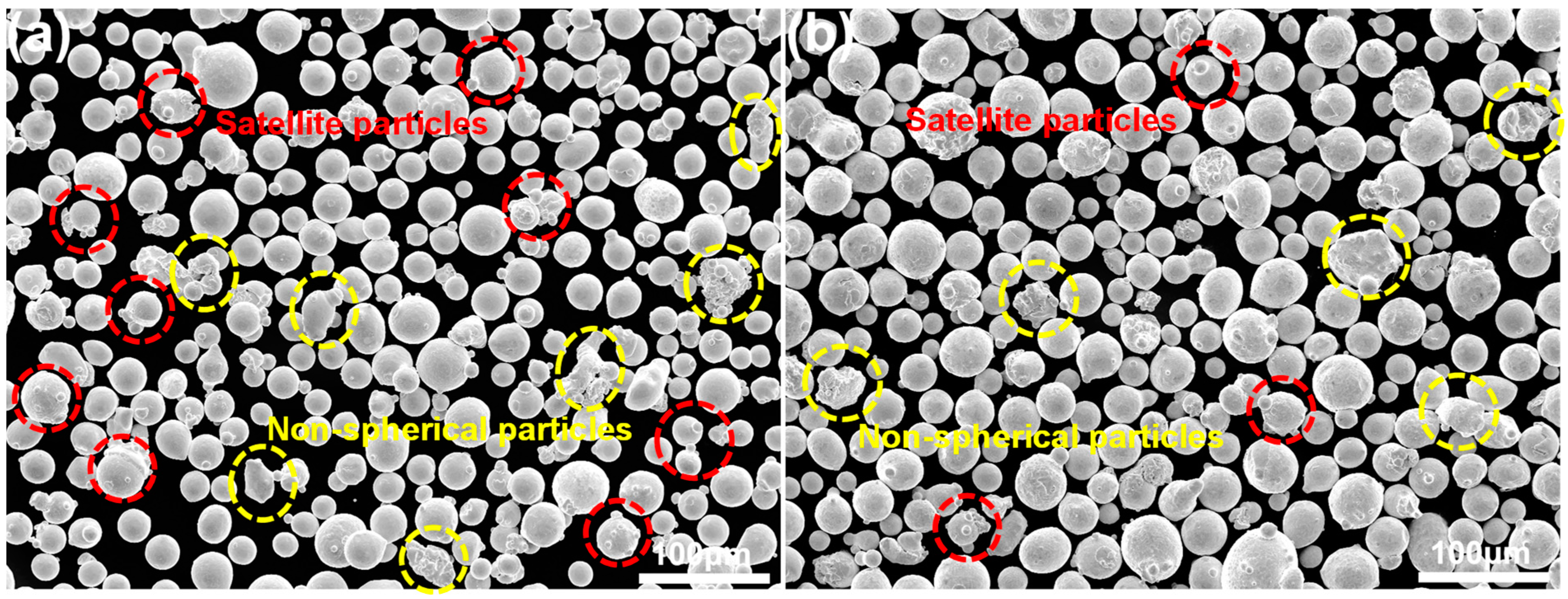

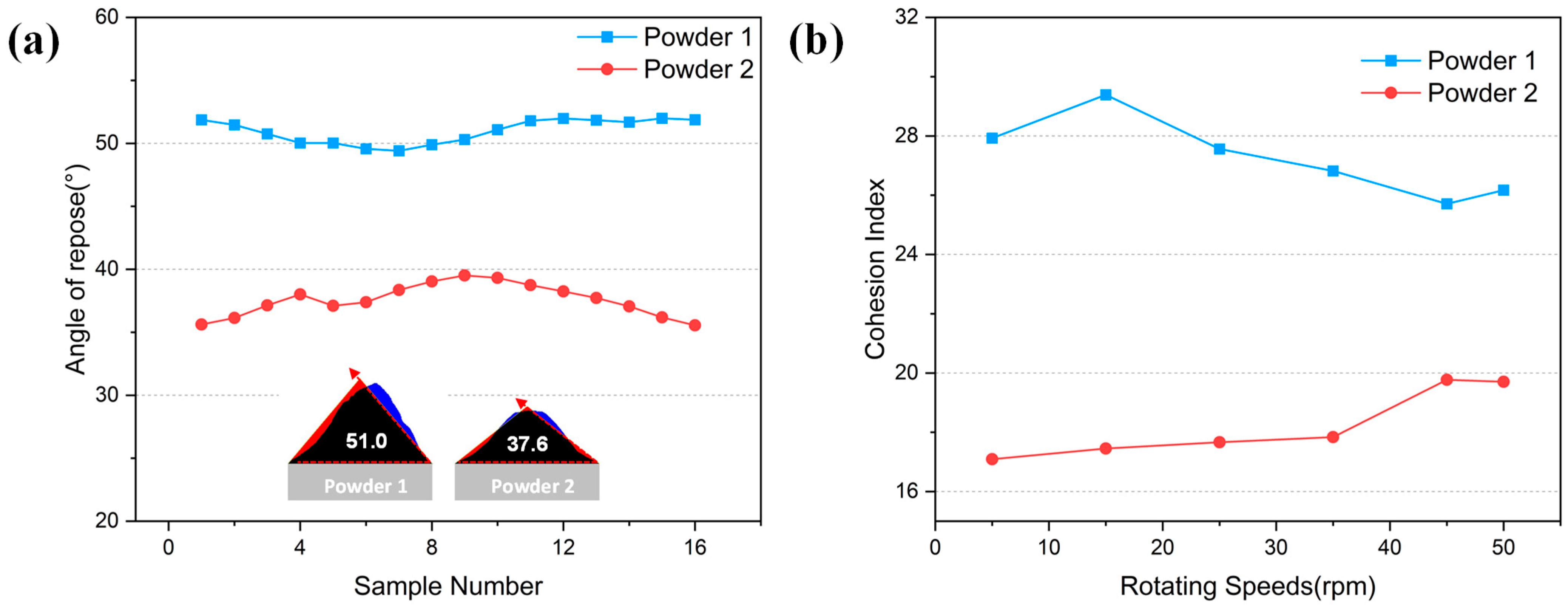


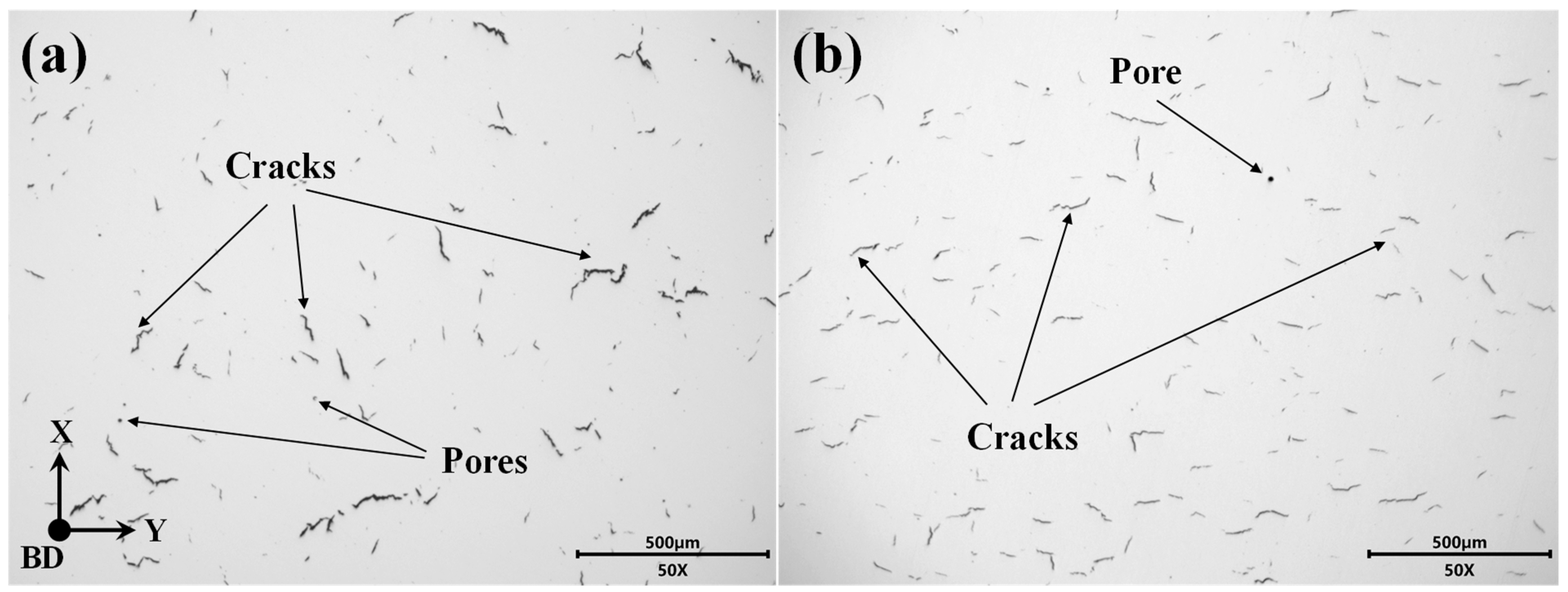
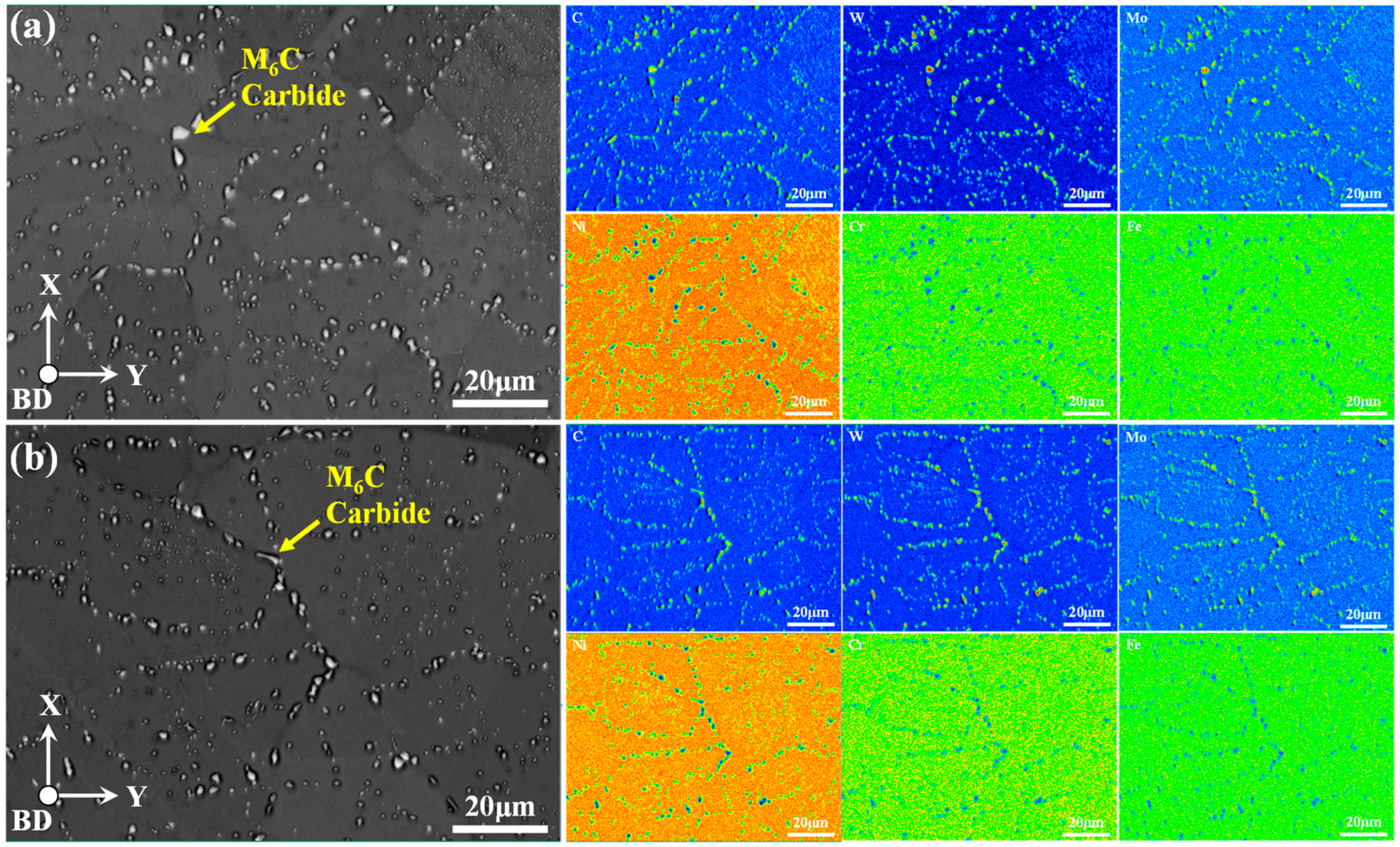
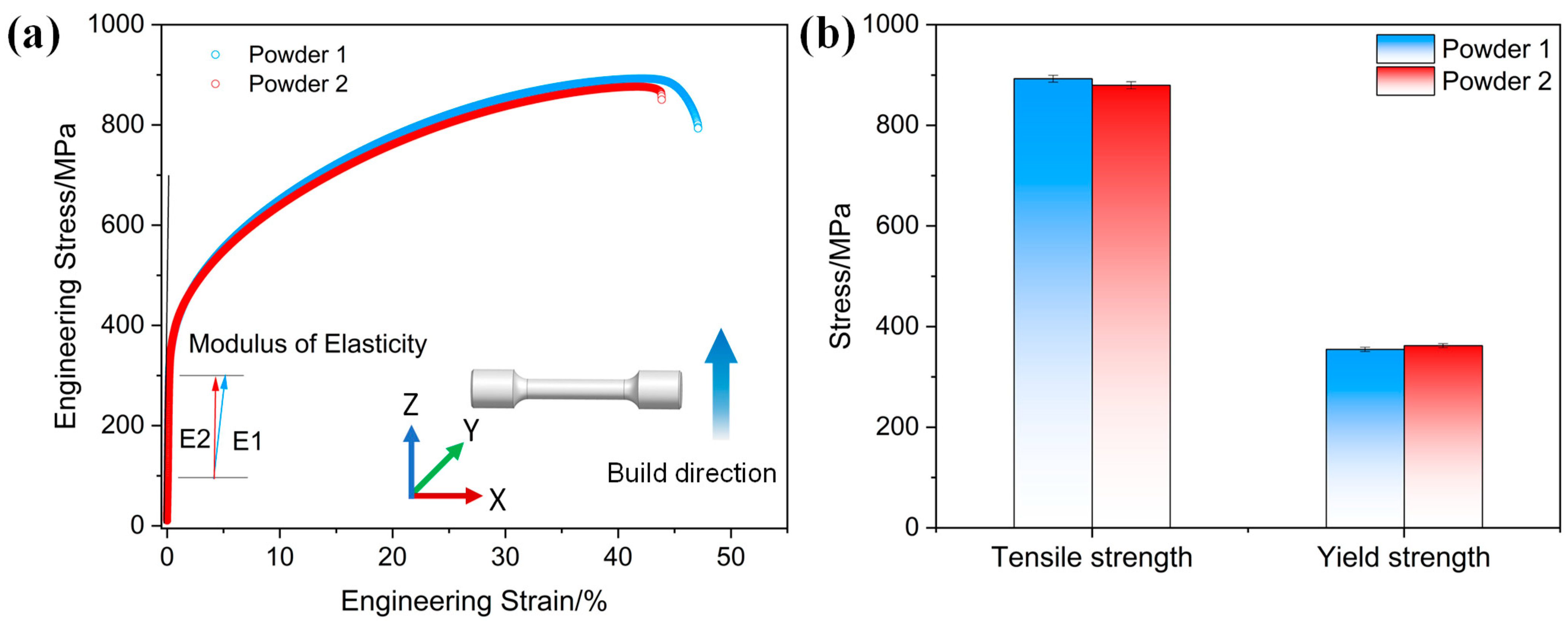
| Element | C | Cr | B | Al | Fe | Mn | Mo |
|---|---|---|---|---|---|---|---|
| Haynes 230 | 0.058 | 20.95 | 0.0052 | 0.45 | 1.76 | 0.69 | 2.15 |
| Element | Ti | Co | Si | La | W | Ni | / |
| Haynes 230 | 0.009 | 0.32 | 0.47 | 0.005 | 13.46 | Bal. | / |
| Sample | D 10 (μm) | D 50 (μm) | D 90 (μm) | Span |
|---|---|---|---|---|
| Powder 1 | 22.625 | 31.603 | 44.036 | 0.67 |
| Powder 2 | 23.582 | 32.758 | 45.426 | 0.67 |
| Element | Powder 1 (ppm) | Powder 2 (ppm) |
|---|---|---|
| O | 110 | 180 |
| Samples | Bulk Density (g/cm3) | Tap Density (g/cm3) | Hausner Ratio | Powder Bed Density (g/cm3) |
|---|---|---|---|---|
| Powder 1 | 4.71 | 5.63 | 1.20 | 5.58 |
| Powder 2 | 5.05 | 5.72 | 1.13 | 5.67 |
| Samples | Laser Power (W) | Scanning Speed (mm/s) | Volume Energy Density (J/mm3) |
|---|---|---|---|
| 1 | 140 | 700 | 74.07 |
| 2 | 180 | 700 | 95.24 |
| 3 | 180 | 1500 | 44.44 |
| 4 | 220 | 900 | 90.53 |
| 5 | 220 | 1000 | 81.48 |
| 6 | 220 | 1100 | 74.07 |
Disclaimer/Publisher’s Note: The statements, opinions and data contained in all publications are solely those of the individual author(s) and contributor(s) and not of MDPI and/or the editor(s). MDPI and/or the editor(s) disclaim responsibility for any injury to people or property resulting from any ideas, methods, instructions or products referred to in the content. |
© 2024 by the authors. Licensee MDPI, Basel, Switzerland. This article is an open access article distributed under the terms and conditions of the Creative Commons Attribution (CC BY) license (https://creativecommons.org/licenses/by/4.0/).
Share and Cite
Zhang, P.; Bi, Z.; Wang, R.; Wang, L.; Liu, G.; Sun, G.; Zhang, S. Enhancement of Spreadability in Haynes 230 Powder via In Situ Micro-Oxidation Gas Atomization for Additive Manufacturing Process. Coatings 2024, 14, 177. https://doi.org/10.3390/coatings14020177
Zhang P, Bi Z, Wang R, Wang L, Liu G, Sun G, Zhang S. Enhancement of Spreadability in Haynes 230 Powder via In Situ Micro-Oxidation Gas Atomization for Additive Manufacturing Process. Coatings. 2024; 14(2):177. https://doi.org/10.3390/coatings14020177
Chicago/Turabian StyleZhang, Peng, Zhongnan Bi, Rui Wang, Lianbo Wang, Guohao Liu, Guangbao Sun, and Shaoming Zhang. 2024. "Enhancement of Spreadability in Haynes 230 Powder via In Situ Micro-Oxidation Gas Atomization for Additive Manufacturing Process" Coatings 14, no. 2: 177. https://doi.org/10.3390/coatings14020177
APA StyleZhang, P., Bi, Z., Wang, R., Wang, L., Liu, G., Sun, G., & Zhang, S. (2024). Enhancement of Spreadability in Haynes 230 Powder via In Situ Micro-Oxidation Gas Atomization for Additive Manufacturing Process. Coatings, 14(2), 177. https://doi.org/10.3390/coatings14020177






